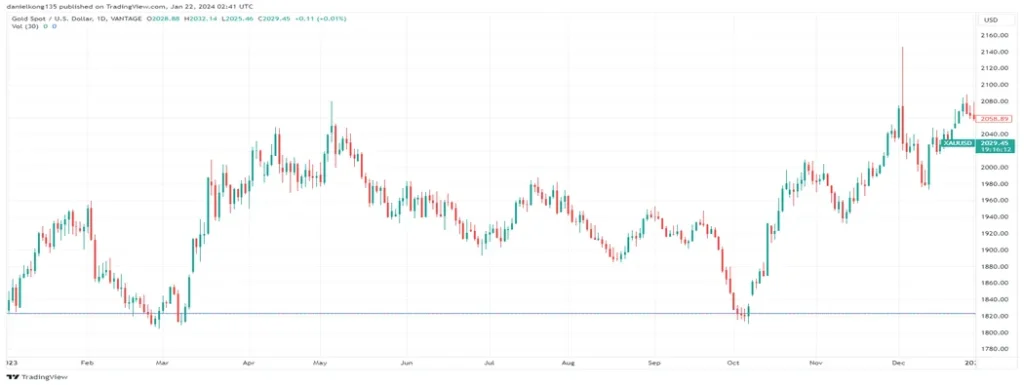Gold, often touted as a “safe haven,” has historically maintained its value even in times of market uncertainty. It is also often sought after for its role as a hedge against economic uncertainties. While gold can be found in our everyday lives, the concept of gold trading might seem daunting to beginners.
In this article, we will break down all you need to know about gold trading and equip you with the basics to help you kickstart your gold trading journey.
What is Gold Trading?
Gold trading is the process of buying and selling gold with the aim of making returns from the price movements.
Gold trading offers a multitude of avenues, including exchange-traded funds (ETFs) or contracts for differences (CFDs). Using CFDs, traders can seize trading opportunities from the price movements of gold without having to own the underlying product.
The valuation of a CFD focuses solely on the price movement between the entry and exit points of the trade. Through CFDs, traders can either trade long (if you believe the price will increase) or short (if you believe the price will fall).
Why Trade Gold?
Here are some reasons to trade gold as a beginner:
1. Stability and Historical Value
Gold has been a valued commodity for centuries, and often seen as a safe asset during times of economic uncertainty. Unlike currencies, which can be affected by government policies and inflation, gold has shown to retain its value over time.
This historical stability can provide beginners with a sense of security when entering the world of trading.
2. Leverage Opportunities
Many CFD trading platforms offer the possibility to trade gold on margin. This means that traders can control a larger position with a relatively smaller amount of capital.
However, this is a double-edged sword. While leverage can help traders amplify their potential returns, it can also magnify the potential losses incurred. It is important for beginners to understand the risk of leverage before trading with high margin.
Trading gold is one way for beginners to diversify your trading portfolio.
Different assets, like stocks, bonds, and commodities, react differently to market events. Beginners can include gold as a different asset in your trading strategy to spread your risk across different asset classes. This diversification can help mitigate potential losses in one product with the potential gains in another.
4. High Liquidity
Gold is considered one of the most liquid products to trade because it is easy to buy and sell, with many buyers and sellers in the market [1].
It can be easily traded in several ways including ETFs, CFDs, options and futures. This plethora of options allows traders to easily enter or exit trading positions. For beginners, this high liquidity will reduce the risk of being trapped in a trade (where there’s no buyer or seller) and provide the flexibility of including or excluding it from your portfolio.
Ready to get started with gold trading? Open a live account with Vantage today and get all the necessary tools and resources to help you begin your gold trading journey.
How Does the Gold Market Work?
The gold market is a marketplace where people buy and sell gold. It’s made up of many different buyers and sellers, including big companies as well as the regular man on the street looking to invest in this precious metal. Gold can be traded through various avenues, such as physical places, online platforms, and special markets.
The price of gold fluctuates based on the demand for purchasing and the quantity available – a concept rooted in supply and demand. These fluctuations can be influenced by global events, significant occurrences, or alterations in monetary systems. Typically, the price is denominated in US dollars, and it may change depending on fluctuations in the value of the currency.
Central banks, institutions providing financial and banking services to the governments, also hold a significant role in the gold market. They engage in buying and selling gold to aid their countries’ monetary policy strategies. Moreover, gold also finds application in diverse industries, including in jewellery production. Together, these elements make the gold market tick.
Understand Gold Trading

Understand What Moves Gold Trading
The gold market is influenced by economic and geopolitical factors worldwide.
One of the major factors influencing the gold price is the global economic outlook. During the time of financial instability or recession, individuals often turn to gold because it is perceived as a stable way to preserve wealth. This increased demand for gold can lead to a surge in price.
Geopolitical tensions, such as conflicts or trade disputes, also exert an influence on gold prices by triggering uncertainty in the broader financial markets. To learn more about the key market events that unfolded in 2022 and how they have reshaped the market, read more about it here.
Central bank policies and interest rates play a significant role as well. When central banks implement policies that lead to lower interest rates, it can weaken the currency and boost gold prices. Additionally, inflationary pressures can drive investors toward gold as a way to preserve their wealth in times of eroding purchasing power.
Learn how to read the gold charts
Gold product price performance is depicted through charts, offering insights into its changes over time. These charts can span various timeframes like minutes, days, weeks, months, or years on the horizontal axis, while the vertical axis represents the corresponding gold product price.

For beginners, examining the price shifts of gold products within their selected timeframe provides a glimpse into its past behaviour. Mastering chart reading will help beginners to identify possible trends or patterns for future trades.
Decide how to trade the Gold
For those new to gold trading, there are several avenues to explore. The most straightforward method is physical gold trading. Alternatively, beginners can also consider derivative instruments like CFDs, futures, and options for their gold trading endeavours.
With Vantage, beginners have the opportunity to engage in gold trading through various options such as gold ETF CFDs or the Live Gold Spot to US Dollar rate (XAU/USD CFD). It’s important to note that while trading these derivatives, you do not actually possess the physical gold; instead, you will trade based on the difference between the product’s opening and closing prices. This offers the flexibility to take either a long position (if you expect the market to rise) or a short position (if you anticipate a market decline), enabling you to capitalise on both bull and bear market movements.
Trading gold through CFDs also offers the advantage of using leverage, which amplifies exposure to price movements. However, leveraged gold trading comes with considerable risk and is not suitable for long-term trading as it can lead to steep losses quickly.
Beginner Gold Trading Tips
When it comes to gold trading, there are various strategies that beginners can explore on their trading journey. You can use fundamental trading strategies to measure the intrinsic value of gold through its economic and financial factors. You can also employ technical analysis to analysing the gold price charts using various trading tools. These tools can assist in identifying patterns or trends that might influence the price movements of XAU/USD.
- Know the Gold Trading Hours
Gold trades can take place around the clock worldwide due to the global nature of the market. The gold market operates 24 hours a day, five days a week, allowing traders to engage in continuous trading activities. This extended trading period is made possible by the overlapping trading sessions of major financial centres in different time zones.
Although gold trades happen around the clock, beginners can find most of the market liquidity during New York trading hours. You can trade during peak hours where there’s plenty of liquidity and low volatility. However, always remember that volatility could come with an added risk of losses due to greater market movement.
- Have a solid gold trading strategy
For beginners, a thoughtfully planned gold trading strategy is important. It serves as your guiding light, offering direction and structure you execute your gold trades.
The right trading strategy will enable you to determine entry and exit positions, ensuring potential losses are contained and their trades safeguarded. Emotional reactions often prompt impulsive trading choices, leading to expensive errors for beginners. Having a structured trading strategy helps minimise these biases, promoting a steady trading methodology.
With a precise and robust trading strategy, coupled with effective risk management, you can be better prepared to navigate the intricacies of gold trading.
Key Takeaways for Gold Trading for Beginners
There are a few aspects that beginners should keep an eye out for when engaging in gold trading. This includes gaining an understanding of the factors that influence gold prices, such as economic shifts, geopolitical tensions, and central bank policies.
To help beginners gain a better understanding of gold trading, sign up for a demo account with Vantage now. Test your trading skills using virtual credits to gain a better understanding of the markets. Alternatively, if you are prepared to commence trading gold CFDs, open a live account with Vantage and embark on your trading journey today.
Reference
- “Why gold is a liquid asset (and what that means for investors) – CBS News” https://www.cbsnews.com/news/why-gold-is-liquid-asset-what-that-means-for-investors/ Accessed 14 Aug 2023



